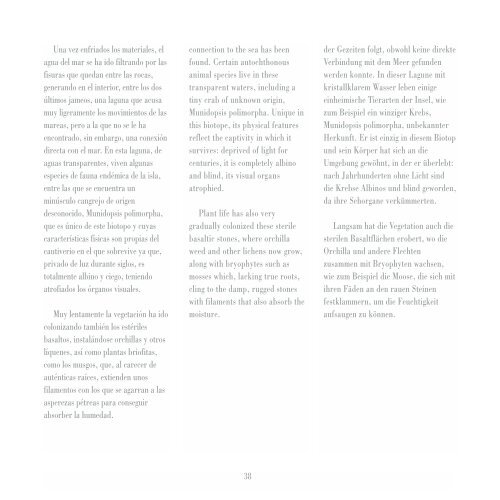Jameos del Agua - Fundación César Manrique
Jameos del Agua - Fundación César Manrique
Jameos del Agua - Fundación César Manrique
Erfolgreiche ePaper selbst erstellen
Machen Sie aus Ihren PDF Publikationen ein blätterbares Flipbook mit unserer einzigartigen Google optimierten e-Paper Software.
Una vez enfriados los materiales, el<br />
agua <strong>del</strong> mar se ha ido filtrando por las<br />
fisuras que quedan entre las rocas,<br />
generando en el interior, entre los dos<br />
últimos jameos, una laguna que acusa<br />
muy ligeramente los movimientos de las<br />
mareas, pero a la que no se le ha<br />
encontrado, sin embargo, una conexión<br />
directa con el mar. En esta laguna, de<br />
aguas transparentes, viven algunas<br />
especies de fauna endémica de la isla,<br />
entre las que se encuentra un<br />
minúsculo cangrejo de origen<br />
desconocido, Munidopsis polimorpha,<br />
que es único de este biotopo y cuyas<br />
características físicas son propias <strong>del</strong><br />
cautiverio en el que sobrevive ya que,<br />
privado de luz durante siglos, es<br />
totalmente albino y ciego, teniendo<br />
atrofiados los órganos visuales.<br />
Muy lentamente la vegetación ha ido<br />
colonizando también los estériles<br />
basaltos, instalándose orchillas y otros<br />
líquenes, así como plantas briofitas,<br />
como los musgos, que, al carecer de<br />
auténticas raíces, extienden unos<br />
filamentos con los que se agarran a las<br />
asperezas pétreas para conseguir<br />
absorber la humedad.<br />
connection to the sea has been<br />
found. Certain autochthonous<br />
animal species live in these<br />
transparent waters, including a<br />
tiny crab of unknown origin,<br />
Munidopsis polimorpha. Unique in<br />
this biotope, its physical features<br />
reflect the captivity in which it<br />
survives: deprived of light for<br />
centuries, it is completely albino<br />
and blind, its visual organs<br />
atrophied.<br />
Plant life has also very<br />
gradually colonized these sterile<br />
basaltic stones, where orchilla<br />
weed and other lichens now grow,<br />
along with bryophytes such as<br />
mosses which, lacking true roots,<br />
cling to the damp, rugged stones<br />
with filaments that also absorb the<br />
moisture.<br />
38<br />
der Gezeiten folgt, obwohl keine direkte<br />
Verbindung mit dem Meer gefunden<br />
werden konnte. In dieser Lagune mit<br />
kristallklarem Wasser leben einige<br />
einheimische Tierarten der Insel, wie<br />
zum Beispiel ein winziger Krebs,<br />
Munidopsis polimorpha, unbekannter<br />
Herkunft. Er ist einzig in diesem Biotop<br />
und sein Körper hat sich an die<br />
Umgebung gewöhnt, in der er überlebt:<br />
nach Jahrhunderten ohne Licht sind<br />
die Krebse Albinos und blind geworden,<br />
da ihre Sehorgane verkümmerten.<br />
Langsam hat die Vegetation auch die<br />
sterilen Basaltflächen erobert, wo die<br />
Orchilla und andere Flechten<br />
zusammen mit Bryophyten wachsen,<br />
wie zum Beispiel die Moose, die sich mit<br />
ihren Fäden an den rauen Steinen<br />
festklammern, um die Feuchtigkeit<br />
aufsaugen zu können.















![Becas y premios de la Fundación César Manrique [1997-2006]](https://img.yumpu.com/20766851/1/184x260/becas-y-premios-de-la-fundacion-cesar-manrique-1997-2006.jpg?quality=85)
